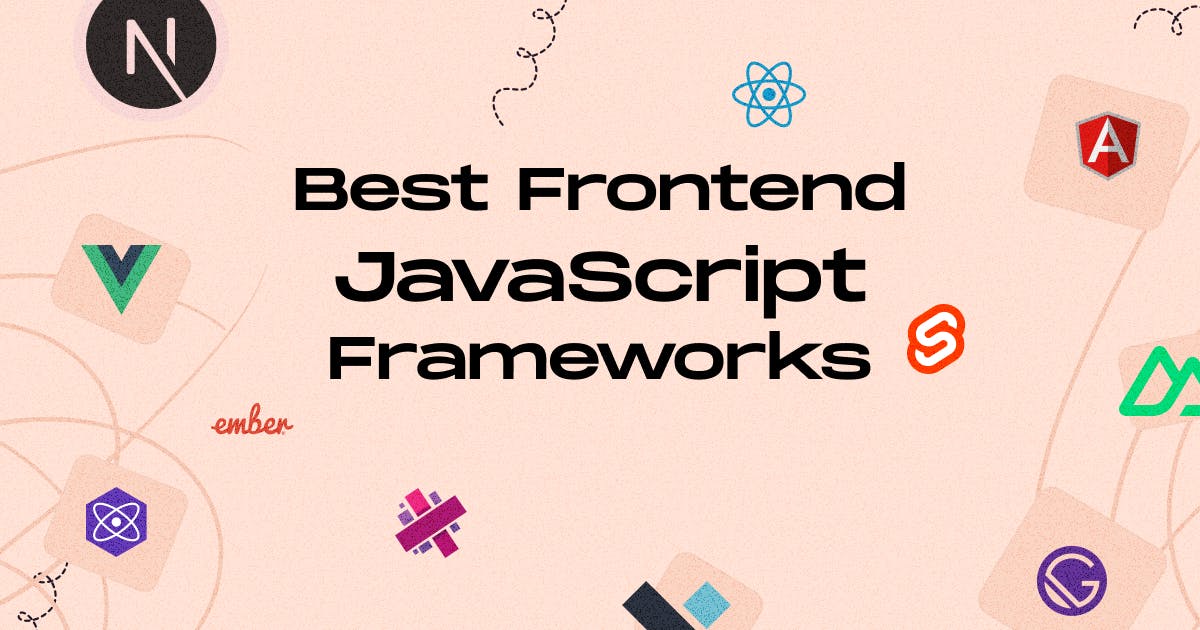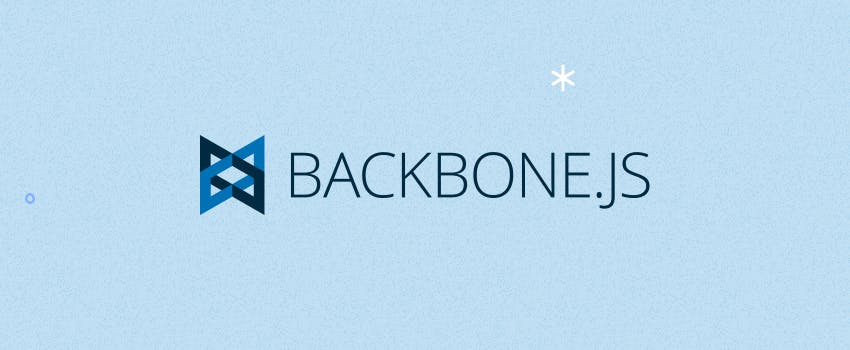November 22, 2023
12 Best Frontend JavaScript Frameworks

Nusrat Sarmin

JavaScript, the ubiquitous programming language of the web, plays a crucial role in web development. To harness the full potential of JavaScript, developers rely on JavaScript frameworks. These frontend JS frameworks considerably save development time and effort while still delivering excellent performance.
Notably, there are a plethora of excellent front-end frameworks available for web application development. In this blog post, we'll explore some of the best frontend JavaScript frameworks that are going to dominate front-end web development.
What Is a JavaScript Framework?
A JavaScript Framework is a collection of pre-built components, libraries, and tools to simplify the process of building web applications. It's a structured foundation for developing interactive, dynamic, and responsive user interfaces with ease. Frameworks abstract away many low-level tasks and allow developers to focus on high-level application logic. JavaScript is commonly used in frontend development, but it has also gained popularity in backend development in recent years.
What are The Best Frontend Javascript Frameworks?
Popular JavaScript frameworks include React, Next, Angular, Vue.js, Ember.js, Svelte.js, and more. Each framework has its own strengths, features, use cases, and drawbacks. Let's dive in to see all the top-rated Javascript Frameworks.
1. React
React, developed and maintained by Facebook, is a dominant player in the front-end development landscape. React empowers developers to create scalable and future-proof projects. The component-based architecture makes it easy for developers to reuse code across different projects. Additionally, its virtual DOM (Document Object Model) helps speed up the development process. For the present and upcoming years, React will remain a top choice for developers due to its full-fledged nature and development efforts.

Pros and Cons Of React
Pros Of React
✅ Virtual DOM: React uses a virtual DOM that minimizes direct manipulation of the actual DOM. Additionally, it allows users to update only the changed parts of the page. Thus, it results in faster rendering and a smoother user experience.
✅ Component-based Architecture: React breaks down UIs into smaller, reusable components, making code management and reusability easier.
✅ Unidirectional Data Flow: React enforces one-way data flow, which facilitates predictable data flow, and easier code debugging.
✅ React Hooks: The introduction of React Hooks simplified state management and lifecycle-related logic, improving code organization.
✅ Performance Optimization: React offers a range of tools and techniques to enhance performance, including code splitting, lazy loading, and efficient handling of complex and heavy applications.
Cons of React
❌ Steep Learning Curve: React can be challenging for beginners.
❌ Boilerplate Code: In larger applications, React may result in a lot of boilerplate code. This can potentially lengthen development time and complicate the code.
❌ JSX Syntax: Developers who are used to traditional HTML templating may find JSX unfamiliar and need some time to learn.
❌ Ecosystem Complexity: React has a lot of options, which can make it hard to choose.
2. Next.js
Next.js is a powerful React-based framework backed by Vercel. Next.js allows developers to build full-stack Web applications. It incorporates the latest React features and utilizes efficient Rust-based JavaScript tooling for quick builds. Even more, it's great for building fast and SEO-friendly JAMstack websites.

Its on-demand features, flexibility in choosing between SSR and SSG, close integration with React, and broad developer community make it a top choice for many developers. Though it is particularly designed for React, it can also be used with other front-end libraries or frameworks.
Pros and Cons of Next.js
Pros of Next.js
✅ Server-Side Rendering (SSR): Next.js enables server-side rendering, webpages can be generated on the server. This improves SEO and initial load times and provides a better user experience.
✅ Extensibility: You can add plugins and customize your build process to tailor it to your project's unique requirements.
✅ Automatic Code Splitting: Automatically splits code into smaller, optimized chunks for faster load times. So, only the JavaScript needed for a specific page is loaded.
✅ Built-in Asset Optimization: Next.js comes with built-in asset optimization. Automatic image, fonts, scripts, and optimization for improved performance.
✅ Built-in Routing: Next.js automatically generates routes for all pages in an app based on their file structure. This reduces the need for complex routing configurations.
Cons of Next.js
❌ Learning Curve: This can be complex for beginners, especially those new to React.
❌ Overkill for Simple Projects: The extensive features of Next.js can be overkill for small, simple projects.
❌ Limited Built-In Backend Support: Since Next.js is primarily a frontend framework, it has limited support for database services.
❌ Heavy Server-Side Processing: Not recommended for applications with heavy server-side processing needs.
❌ Specifically Designed for React: There is limited support available for non-React applications.
3. Vue.js
Vue.js is an open-source Javascript framework for building user interfaces and single-page applications. This progressive framework provides a simple yet powerful solution for developing modern web applications with its reactive components and declarative syntax. Evan You, a former Google employee, created it in 2014. Since then, it has been maintained by the Vue developer community.

It is often compared to other popular frameworks like React and Angular, but Vue stands out for its simplicity, approachability, and gentle learning curve. Vue.js offers a 2-way data binding like Angular.js and a Virtual DOM like React.js.
Pros and Cons of Vue.js
Pros of Vue.js
✅ Simple and Intuitive Syntax: Vue's syntax is clear, concise, and easy to understand. Hence, it is suitable for both new and experienced developers.
✅ Progressive: Vue.js can be incrementally adopted into existing projects. This flexibility allows developers to use as much or as little of the framework as needed.
✅ Declarative Rendering: Vue promotes the use of reusable components, making code easier to maintain, reuse, and collaborate on.
✅ Reactivity: Vue.js's reactivity system automates UI updates by tracking data changes, reducing manual DOM manipulation.
✅ Active Community and Ecosystem: Vue has a dedicated community of developers. It also has a rich ecosystem of libraries, plugins, and tools to enhance development.
Cons of Vue.js
❌ Smaller Ecosystem: Vue's ecosystem is strong, but not as extensive as React or Angular.
❌ Limited Tooling: Vue.js does provide tools like Vue CLI for project setup and development. However, it may not offer the same level of tooling as some competing frameworks.
❌ Limited Corporate Backing: Vue.js may not have the same level of corporate backing and resources as other major frameworks, which could raise concerns about long-term support.
❌ Language Constraint: VueJS was developed by Chinese developers and is widely used in China. Most of the resources are in Chinese, which can be a barrier for English-speaking users.
❌ Exessive Code Flexibility: Flexibility offers numerous opportunities for programmers. However, flexibility can result in increased irregularity and errors in code.
4. Angular
Angular is a comprehensive JavaScript framework developed by Google. It is written in TypeScript and is known for its modularity, extensibility, and thriving ecosystem.
Angular offers features like two-way data binding, directives, dependency injection, and a component-based architecture. Developers get a powerful and structured way to web development with Angular. It is well-suited to build dynamic, single-page web applications (SPAs) with rich user interfaces as well as large-scale projects.

Pros and Cons of Angular
Pros of Angular
✅ Modularity and Component-Based Architecture: Angular promotes a component-based architecture, which enables the creation of reusable and encapsulated components. This modularity makes development more manageable.
✅ Rich Ecosystem: Angular has a complete ecosystem with various libraries, tools, and extensions like Angular CLI, Angular Material, and NgRx.
✅ Robust Routing: Angular's built-in router enables smooth and SEO-friendly navigation in single-page applications.
✅ Dependency Injection: Angular has a built-in dependency injection system that helps manage application dependencies, promotes modularity, and simplifies testing.
✅ Performance Optimization: Performance optimization methods such as Ahead-of-Time (AOT) compilation, lazy loading, and tree-shakable dependencies, lead to faster load times.
Cons of Angular
❌ Development Speed: Using strict architectural patterns and TypeScript may hinder development speed, especially for teams unfamiliar with these technologies.
❌ Large Bundle Size: Angular applications may have a larger bundle size compared to other frameworks like React or Vue.
❌ Upgrading Challenges: Angular is constantly evolving. Upgrading Angular versions can be tough because of breaking changes, making it hard to keep applications up-to-date.
❌ SEO Challenges: Single-page applications (SPAs) created with Angular may face difficulties in search engine optimization (SEO) if not configured correctly.
❌ Boilerplate Code: Angular requires a lot of boilerplate code, which can make development more verbose and time-consuming.
5. Ember.js
Ember.js or simply Ember is an open-source JavaScript framework that follows the Model-View-Controller (MVC) architecture. Yehuda Katz, the creator of Ember is one of the chief creators of jQuery. Ember.js was initially known as SproutCore 2.0. With its foundation in the Handlebars templating engine and powerful tools, Ember streamlines web application development.
Ember.js is worth considering if you're looking for a stable, opinionated, and productive framework.

Pros and Cons of EmberJS
Pros of EmberJS
✅ Convention and Best Practices: Ember.js promotes the use of conventions and best practices. This makes it easier to collaborate on larger projects and ensures that everyone on the team follows the same path.
✅ Ember CLI: Ember CLI is a command-line tool for automating common tasks such as project setup, building, and deployment. It also provides code generators for creating components, routes, and more.
✅ Ember Data: The built-in Ember Data library simplifies data modeling by providing a standardized way to interact with APIs and databases. It saves time and reduces errors.
✅ Extensive Documentation and Active Community: Ember.js benefits from an active and dedicated community that offers support through forums, meetups, and extensive documentation.
✅ Highly Scalable: It is designed with scalability in mind and is well-suited for building large and complex web applications.
Cons of Ember.js
❌ Customization Challenges: The framework's strong opinions and conventions can present challenges when trying to customize certain aspects of your application.
❌ Comparatively Smaller Eco-system: Ember has a strong ecosystem, but other JavaScript frameworks such as React, Angular, and Vue.js have a wider range of third-party libraries and resources.
❌ Overkill Smaller Project: Due to its steep learning curve and complexity, it is less suitable for smaller projects.
6. Svelte
Svelte is another free and open-source front-end framework. It was initially introduced in 2016 by Rich Harris and maintained by the Svelte core team members. Though, it is relatively new but a compelling choice in the ever-growing frontend web development.

Svelte.js distinguishes itself by being a compiler-based framework. The code is compiled during development, resulting in optimized and minimal JavaScript code for the browser. This approach leads to smaller bundle sizes and improved runtime performance, providing a significant advantage in speed and efficiency. Additionally, its component-based approach simplifies the creation of interactive web applications.
Pros and Cons of Svelte
Pros of Svelte
✅ Performance: Highly optimized, resulting in faster load times and improved runtime performance.
✅ Component-based Structure: It promotes modular and reusable components, which helps with organizing and scaling code.
✅ Reactive Simplicity: The intuitive reactive paradigm, making state management and responsive interfaces more straightforward.
✅ SEO-friendly: In contrast to other frameworks, Svelte is SEO-friendly and does not face difficulties with search engine crawlers.
✅ Rendering: Svelte effortlessly handles both client-side and server-side rendering.
Cons of Svelte
❌ Svelte is newer than other popular frameworks, so it may have fewer third-party libraries and tools.
❌ Tooling and IDE support for this framework may not be as extensive as for other more established frameworks.
❌ There are fewer prebuilt UI components in comparison to React and Vue.
7. Nuxt
Nuxt is a popular JavaScript framework that builds on top of Vue.js. It is projected to be one of the best web development frameworks. Nuxt comes with many features that enhance developer productivity and improve the end-user experience.

Nuxt is designed to simplify the development of Vue.js applications by providing a structured and opinionated setup or server-side rendering, routing, and more. It incorporates the best practices and patterns commonly used in Vue.js development. The framework also offers a wide range of features to help developers create robust, server-rendered, and highly performant web applications.
Pros and Cons of Nuxt
Pros of Nuxt
✅ SEO-Friendly: Nuxt applications are SEO-friendly due to server-side rendering and improved page load times.
✅ Extensibility: Nuxt's modular architecture lets you add more features and extend your application's functionality.
✅ Automatic Code Splitting: Nuxt automatically splits your code into smaller, optimized chunks, resulting in a reduced initial bundle size and loading time.
✅ Layout System: Nuxt has a flexible layout system. You can create and reuse layouts for different parts of your application, ensuring consistent design.
✅ Community and Ecosystem: Nuxt has a supportive community and a growing ecosystem of plugins and modules.
Cons of Nuxt
❌ Performance Overhead: Server-side rendering can have performance overhead, and it may not be necessary for all projects. If SSR is not required, Nuxt may not be the best choice.
❌ Limited Configuration Flexibility: Nuxt follows a convention-over-configuration approach, which is good for consistency but may limit flexibility in your project's setup.
❌ Dependency on Vue.js: Nuxt is tightly coupled with Vue.js. So if you prefer a different JavaScript framework or library, you'll need to consider other options.
8. Preact
Preact is an open-source, fast, and performant JavaScript library for building web applications. It is a simplified version of React created by Jason Miller, a developer at Google. Preact shares many of the same concepts and syntax as React including a virtual DOM and component-based architecture.

One of the key features of Preact is its small size. The library is incredibly lightweight, coming in at just around 3KB when gzipped. Preact is known for its performance, low memory usage, and support for server-side rendering. It is a reliable choice for applications that prioritize speed and efficiency.
Pros and Cons of Preact
Pros Of Preact
✅ Tiny in Size: Preact is significantly smaller than other Frameworks. Hence it allows for faster page loading times and more efficient code execution.
✅ Performance: Preact is highly performant not only for its small size. It also has the fastest Virtual DOM libraries and an efficient diff implementation.
✅ React Compatibility: Preact is designed to be fully compatible with React, making the shift from React to Preact straightforward. Most React components and libraries can be used in Preact without any modifications.
✅ Server-side Rendering: Preact provides support for server-side rendering, making it a suitable option for creating universal applications that can render on both the client and server.
Cons of Preact
❌ Smaller Ecosystem and Community: Preact has a small eco-system and community compared to other popular frameworks like React.
❌ No Synthetic Event Handling: Preact is built on a browser API and lacks support for synthetic event handling. This can impact application performance and create maintenance challenges when using React for development and Preact for production.
9. Gatsby
Gatsby is built on top of React, a popular JavaScript library for building user interfaces. It is often referred to as a "framework," but it's more accurately described as a static site generator. The primary purpose of it is to generate static websites, which means it pre-builds HTML, CSS, and JavaScript files.
This open-source framework leverages the power of React, GraphQL, and Webpack to help developers create fast, secure, and SEO-friendly websites.

Pros and Cons of Gatsby
Pros of Gatsby
✅ Blazing-Fast Performance: Gatsby creates static websites with fast loading times and excellent performance. Pre-built files can be served from a CDN for optimized loading speeds.
✅ SEO-Friendly: Gatsby is optimized for SEO, making it easier for your site to rank well in search results.
✅ Great Developer Experience: Gatsby makes it easy to get started and build with hot-reloading, plugins, and a large community.
✅ Progressive Web App (PWA) Capabilities: Gatsby can easily be turned into a full-featured PWA, offering features of top-notch performance, offline support, push notifications, and enhanced mobile experience.
✅ Secure: Gatsby websites are secure because they don't have server-side code or a database for attackers to target.
Cons of Gatsby
❌ Longer Build Times: Building Gatsby sites can be time-consuming, particularly for large websites with extensive content. This will result in a notable decrease in website performance.
❌ Not recommended for large-scale websites.
❌ Limited Dynamic Content: Gatsby is primarily designed for static websites, which can present difficulties in managing dynamic content. Real-time data updates or complex server-side logic may need extra steps.
❌ Learning Curve: Gatsby can be difficult to learn if you're new to React, GraphQL, or modern web development. Switching from other platforms like WordPress to Gatsby may also be challenging for users to understand the new system. It'll temporarily affect productivity.
10. Aurelia
Aurelia is a framework that often goes unnoticed but deserves recognition. Its features make it one of the best frontend Javascript frameworks.
Aurelia is a client-side JavaScript framework that helps developers create rich and engaging web applications. Developed by Rob Eisenberg in 2016. It was created with a focus on simplicity, modularity, and flexibility. The Aurelia framework is described as a "next-generation" framework, that aims to make the development process smooth and enjoyable.

Pros and Cons of Aurelia
Pros of Aurelia
✅ Extensible and Modular: Aurelia is designed to be flexible and easy to customize. You can choose which features to use, making your application smaller. It also has a plugin system for adding extra functionality, making it suitable for various projects.
✅ Large Ecosystem: Aurelia is a comprehensive platform with a rich ecosystem, designed to support your rapid development. It offers state management, internationalization, and validation as official plugins from the core team. Also provide optional tools such as CLI, VS Code plugin, and Chrome debugger.
✅ High Performance: Aurelia offers consistent and scalable performance, even with a complex UI.
✅ Easy coding with conventions: Conventions simplify coding and business logic. Aurelia is the only framework that puts your code at the center of your app. Besides, if you don't like conventions. You can choose to plug in your own or simply remove them. You have the power to make decisions.
✅ Comprehensive Routing: Aurelia has a powerful routing system for complex routing configurations in your application. This feature is great for building SPAs with multiple views.
Cons of Aurelia
❌ Smaller Community and Ecosystem: Aurelia has a smaller community and ecosystem compared to other frameworks like React or Angular.
❌ Market Demand: The demand for Aurelia developers may be lower in the job market compared to more popular frameworks.
11. Backbone.js
Backbone.js is a JavaScript framework that provides a structure for developing web applications in a clean and organized manner. Jeremy Ashkenas, the creator of CoffeeScript and Underscore.js, developed it, and it was released in 2010.
Backbone.js adheres to the Model-View-Controller (MVC) architectural pattern, which enables developers to separate concerns and create scalable applications. It has a RESTful JSON interface for connecting to an API. Because of its lightweight and minimalistic design, it is used to build Single page applications and client-side web applications.

Pros and Cons of Backbone.js
Pros of Backbone.js
✅ Modular and Scalable: Backbone.js helps you structure your code in a scalable and maintainable way. Adding new features and functionality to your application is easy as it grows.
✅ Light and Minimal: Backbone.js is recognized for its small and efficient size. It's flexible and allows developers to organize their code as they prefer.
✅ Compatibility: Backbone.js works well with other libraries and frameworks like jQuery and Underscore.js. You can easily incorporate Backbone.js into your current projects or use it alongside other technologies.
✅ Syncing and Data Handling: Backbone.js offers models and collections to manage data and handle synchronization with a server. This can simplify data management and promote clean code.
Cons of Backbone.js
❌ Lack of Opinionation: Flexibility is a pro, but it can also be a hustle. Backbone.js doesn't enforce conventions, which can cause inconsistency and challenges for larger teams to collaborate effectively.
❌ Boilerplate Code: Developers may need to write more code for lack of certain abstractions and automation, which can slow down development.
❌ Limited Built-in Features: Backbone.js provides the basic structure for your app, but you might need other libraries for features like two-way data binding and templating.
12. Alpine.js
Alpine.js is a powerful tool for building web interfaces with minimal overhead. It was created by Caleb Porzio. Alpine.js was inspired by TailwindCSS and was formerly known as “Tailwind for JavaScript.” This one is also another undervalued framework but it is worth a place in the best Frontend Javascript frameworks list.
This lightweight, declarative, and performance-oriented approach is a collection of 15 attributes, 6 properties, and 2 methods.

Unlike larger frameworks like Vue.js or React, Alpine.js is ultra-lightweight. Thus, it's a perfect choice for small to medium-sized projects where a highly advanced framework might be overkill.
Pros and Cons of Alpine.js
Pros of Alpine.js
✅ Simple and easy to learn: Alpine.js is known for its simplicity and minimal learning curve. If you have basic knowledge of HTML and JavaScript, you can quickly start using it.
✅ Reactivity: Alpine is "reactive" in the sense that when you change a piece of data, everything that depends on that data "reacts" automatically to that change.
✅ Pre-built Components: Provides Well-built, robust UI components like modals, dropdowns, tabs, etc.
✅ Declarative Syntax: Alpine.js employs declarative syntax, which means you describe what you want to happen, and the framework handles the implementation. This can lead to cleaner and more maintainable code while reducing the risk of bugs.
✅ Provides custom code and tutorials for integrating with the most popular open-source libraries and tools without any hassle.
Cons of Alpine.js
❌ Not a full-fledged framework like React or Vue.
❌ Comparatively smaller community and eco-system.
How to Choose the Best Frontend JavaScript Frameworks?
The best JavaScript framework for your project will depend on your unique requirements and a combination of several factors.
➽ Project's goals, objectives, and functionality requirements.
➽ Team's skillset and expertise.
➽ Consider the cost of using a particular framework. There may be associated costs for additional tools, libraries, or premium support.
➽ Flexibility and Customization Capabilities of a Framework.
➽ Check for Scalability, Security, Usability, Community Support etc.
➽ Reviews and Case Studies.
➽ Consider creating prototypes or small test projects with the shortlisted frameworks to get a feel for how they work and how suitable for your project.
The Final Touch
The JavaScript ecosystem is constantly evolving with new frameworks and libraries. So, it's always a good idea to stay updated with the latest developments in the JavaScript community.
The best frontend Javascript frameworks that should be considered at a glance.
✔ React
✔ Next.js
✔ Vue.js
✔ Ember.js
✔ Nuxt
✔ Preact
✔ Gatsby
✔ Aurelia
Are you on a journey to create a fantastic web application but feeling a bit lost in the wilderness of technology stacks? Don't worry; StaticMania is ready to help you find the best frontend JavaScript Frameworks for your project. Let's talk!
.
Note: Our editorial team independently picked and reviewed each of the products, frameworks, and platforms we listed. All of the mentioned product’s features and other information were collected independently and dependent on the date this article was published. We cordially request that, before making any decision, please visit the featured websites. Posts may contain affiliate links.

